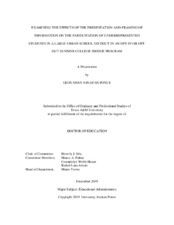| dc.contributor.advisor | Irby, Beverly | |
| dc.creator | Ponce, Geovanny Jonatan | |
| dc.date.accessioned | 2020-09-11T15:22:09Z | |
| dc.date.available | 2021-12-01T08:43:05Z | |
| dc.date.created | 2019-12 | |
| dc.date.issued | 2019-10-22 | |
| dc.date.submitted | December 2019 | |
| dc.identifier.uri | https://hdl.handle.net/1969.1/189160 | |
| dc.description.abstract | College retention and graduation rates among underrepresented students in large urban school districts across the United States are much lower compared to their counterparts. Large urban school districts have also produced low numbers in terms of graduating underrepresented students from high schools across the country. Colleges and universities have created summer bridge programs in response to the low college retention and graduation rates among underrepresented students. These summer bridge programs target the academic and social needs of the incoming student and provide them with the support needed before their official first day at the university or college. The purpose of this study was to examine the participation of selected students in college summer bridge programs, specifically whether participation will be affected by presentation and framing of information before the participant makes the decision to enroll into the college summer bridge program. The significance of the presentation and framing of information will provide more insight on how participation can be increased for college summer bridge programs, especially for underrepresented students.
The study included a random selection of 200 participants from one major high school in a large urban school district in the Houston area. Recruited participants possessed similar demographics such as first generation high school graduates, parents with limited English speaking proficiency, underrepresented populations, and economically challenged. Descriptive statistics was used to summarize the characteristics of the general populations at both campuses. From these participants, four separate groups (Group A, Group B, Group C, and Group D) were created to study the relationship between the categorical variables. A formal presentation was given to two groups of students, while the remaining two groups did not receive a formal presentation regarding the college summer bridge program. A quantitative method, specifically a nonparametric test, and chi-square was utilized to test the correlation between the categorical variables. The categorical variables were the number of frequencies tabulated for participation in either the automatically enrolled or opt in programs. After the level of significance was obtained, a Cramer’s V using crosstabs was used to test the strength of the relationship between the categorical variables. | en |
| dc.format.mimetype | application/pdf | |
| dc.language.iso | en | |
| dc.subject | Summer Programs | en |
| dc.subject | Accountability | en |
| dc.subject | participation | en |
| dc.title | Examining the Effects of the Presentation and Framing of Information on the Participation of Underrepresented Students in a Large Urban School District in an Opt-In or Opt-Out Summer College Bridge Program | en |
| dc.type | Thesis | en |
| thesis.degree.department | Educational Administration and Human Resource Development | en |
| thesis.degree.discipline | Educational Administration | en |
| thesis.degree.grantor | Texas A&M University | en |
| thesis.degree.name | Doctor of Education | en |
| thesis.degree.level | Doctoral | en |
| dc.contributor.committeeMember | Lara-Alecio, Rafael | |
| dc.contributor.committeeMember | Palma, Marco | |
| dc.contributor.committeeMember | Webb-Hasan, Gwendolyn | |
| dc.type.material | text | en |
| dc.date.updated | 2020-09-11T15:22:10Z | |
| local.embargo.terms | 2021-12-01 | |
| local.etdauthor.orcid | 0000-0002-6646-791X | |


